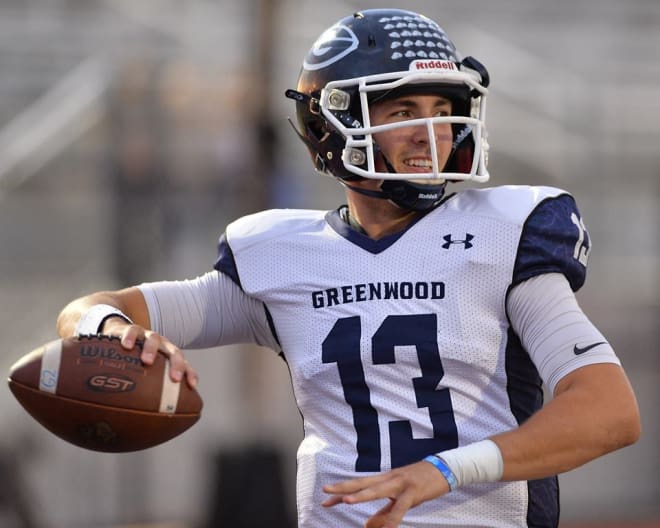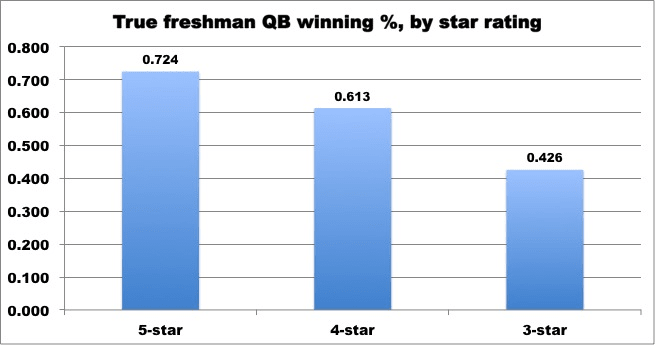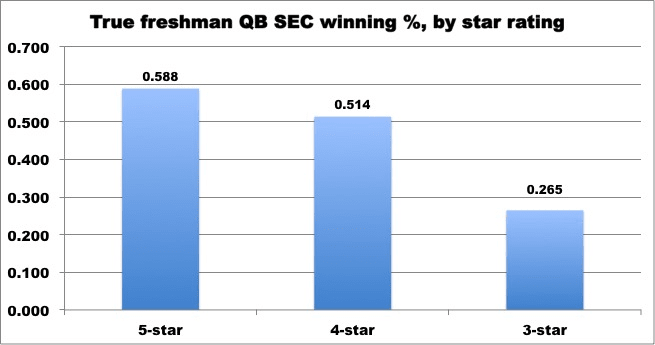HawgBeat Study: How SEC true freshman QBs have fared

The Question
Arkansas’ quarterback situation for 2018 is far from settled, as first-year head coach Chad Morris declined to name a leader for the starting job going into fall camp.
Cole Kelley and Ty Storey split the first-team reps throughout the spring, but neither separated himself from the other. Both players had their moments during the 14 practices and then they put up similar numbers in the Red-White spring game.
It is pretty obvious that there will be growing pains as the Razorbacks shift from the previous staff’s pro-style offense that moved at a slow, methodical pace to Morris’ wide-open, fast-paced spread attack.
That has led some fans to call for one of Arkansas’ two incoming freshman quarterbacks – Connor Noland and John Stephen Jones – to get the job immediately so they can be better prepared for the future. A few fans even think the Razorbacks would be better off with one of them under center in terms of wins and losses in 2018.
All of that is strictly speculation and opinion at this point, as fall camp is still a few weeks away and the season doesn’t begin until Sept. 1 against Eastern Illinois. Instead, one must look to the past for clues.
How have true freshman quarterbacks fared in the SEC? Does their rating coming out of high school correlate to their success? Does starting as a true freshman lead to success down the road?
The answers to those questions should give Arkansas fans an idea of what to expect when it comes to the idea of Noland or Jones starting at quarterback this season.
The Data Set
In order to find those answers, HawgBeat examined every starting quarterback in the SEC over the last 12 seasons, from 2006-2017. Finding the starting quarterbacks for seasons before that time frame proved to be too difficult.
There was one case of a team starting a game in the “Wildcat,” with a running back lined up at quarterback. In 2009, Nu’Keese Richardson is listed as starting at quarterback for Tennessee against Auburn, but we gave the start to Jonathan Crompton because he’s who was truly under center that game.
For Missouri and Texas A&M, we considered only their time in the conference, which began with the 2012 season.
Those parameters gave us a list of 145 different players who had started at least one game at quarterback for an SEC team since 2006. From that point, we whittled the list down to those who started as true freshmen.
That left us with 34 quarterbacks, whom we then examined more closely. We looked up how many games they started as true freshmen, their stats in those games, what they were rated by Rivals coming out of high school and how their careers played out.
The Results
Stats
Those 34 true freshman quarterbacks combined to start 167 games since 2006. Highlighted by guys like Jake Bentley, Jalen Hurts, Jacob Eason and Jake Fromm, there has been a recent uptick in games started by true freshmen.
From 2006-2013, they started an average of 8.8 games. Over the last four seasons, though, that number has increased to 24.3. It peaked in 2016, when true freshmen started 39 games.

Although teams are 100-67 when starting true freshmen under center, they have a sub-.500 record in conference play, at 51-57.
In those games, they have completed 55.8 percent of their passes and average 6.58 yards per attempt, figures that would rank near the bottom of the SEC most years. They also have a 1.4-to-1 touchdown-to-interception ratio.
Half of the true freshmen were listed as dual-threat quarterbacks or athletes coming out of high school. Those guys averaged 4.2 yards per carry and one rushing touchdown every other game.
Stars
Of the 167 games started by true freshman quarterbacks, four- or five-star recruits started 120 of them. That is 71.9 percent, despite there being at least twice as many three-star quarterbacks each year.
Five-star true freshmen have won 72.4 percent of their starts, compared to 61.3 and 42.6 percent by four- and three-star recruits. Looking only at SEC games, five- and four-star recruits have won at a 58.8 and 51.4 percent clip, respectively, compared to 26.5 percent by three-star prospects.


That trend is also reflected in those quarterbacks’ statistics:

None of the season-openers during the span were started by a true freshman, but there have been three cases – all in recent years – of one taking over in Game 2 and holding on to the job the rest of the season. Two of them, Georgia’s Jacob Eason and Jake Fromm, were five-star prospects and the other, Alabama’s Jalen Hurts, was a four-star dual-threat prospect.
Taking it a step further, there have been 15 true freshmen who have started at least five games under center since 2006 and 80 percent of them were four- or five-star recruits.
The only exceptions are Kentucky’s Morgan Newton and Jalen Whitlow, who started seven games apiece in 2009 and 2012, respectively, and Mississippi State’s Wesley Carroll, who started nine games in 2007.
It should be noted that a large factor in the success and failure of these quarterbacks is the talent around them. Teams that land four- and five-star quarterbacks typically also sign recruits of similar caliber at other positions, making the signal caller’s job much easier.
For example, Eason and Fromm benefitted from having Nick Chubb and Sony Michel in the backfield and Hurts is surrounded by NFL talent. When Mitch Mustain started eight games for the Razorbacks in 2006, he was handing the ball off to future first-round picks Darren McFadden and Felix Jones.
As far as the Razorbacks’ two incoming freshmen are concerned, Noland is a three-star signee and Jones is a two-star signee. Over the last 12 seasons, no two-star quarterback has started a game as a true freshman in the SEC.
Careers
An accepted line of thought is that quarterbacks starting games as true freshmen will only pay dividends down the road because of the experience they gain. However, the data suggests otherwise.
Nearly half – 16 to be exact – of the 34 players who started at least one game as a true freshman ended up transferring. (That includes Vanderbilt’s Wade Freebeck, who originally announced his intention to become a graduate transfer following the 2016 season before deciding to quit the game all together and focus on his master’s degree.)
The 47.1 percent transfer rate among those players is much higher than that of players who enrolled at an SEC school and became a starter after their first year on campus. Only 30.7 percent of those players have left their programs.
Of the 18 true freshman starting quarterbacks who didn’t transfer, three of them eventually converted to wide receiver. That group is highlighted by Kentucky’s Randall Cobb, who went back and forth between the positions in college before becoming a Pro Bowl receiver with the Green Bay Packers. The other two both played at Auburn: Kodi Burns and Jonathan Wallace.
It is still too early to know how Bentley, Fromm, Hurts, Texas A&M’s Kellen Mond, Mississippi State’s Keytaon Thompson and Tennessee’s Will McBride will turn out, but the other nine remaining quarterbacks had varying levels of success.
Georgia’s Matthew Stafford, the No. 1 quarterback recruit in the Class of 2006, was the No. 1 overall pick in the 2009 NFL Draft. Tyler Bray and Joshua Dobbs became full-time starters at Tennessee, as did Jordan Jefferson at LSU.
Going into their senior seasons, Drew Lock and Kyle Shurmur have a shot to break the all-time passing records at Missouri and Vanderbilt, respectively.
Jeremy Johnson (Auburn), Morgan Newton (Kentucky) and Justin Worley (Tennessee), though, started only 10-14 more games the rest of their careers.
